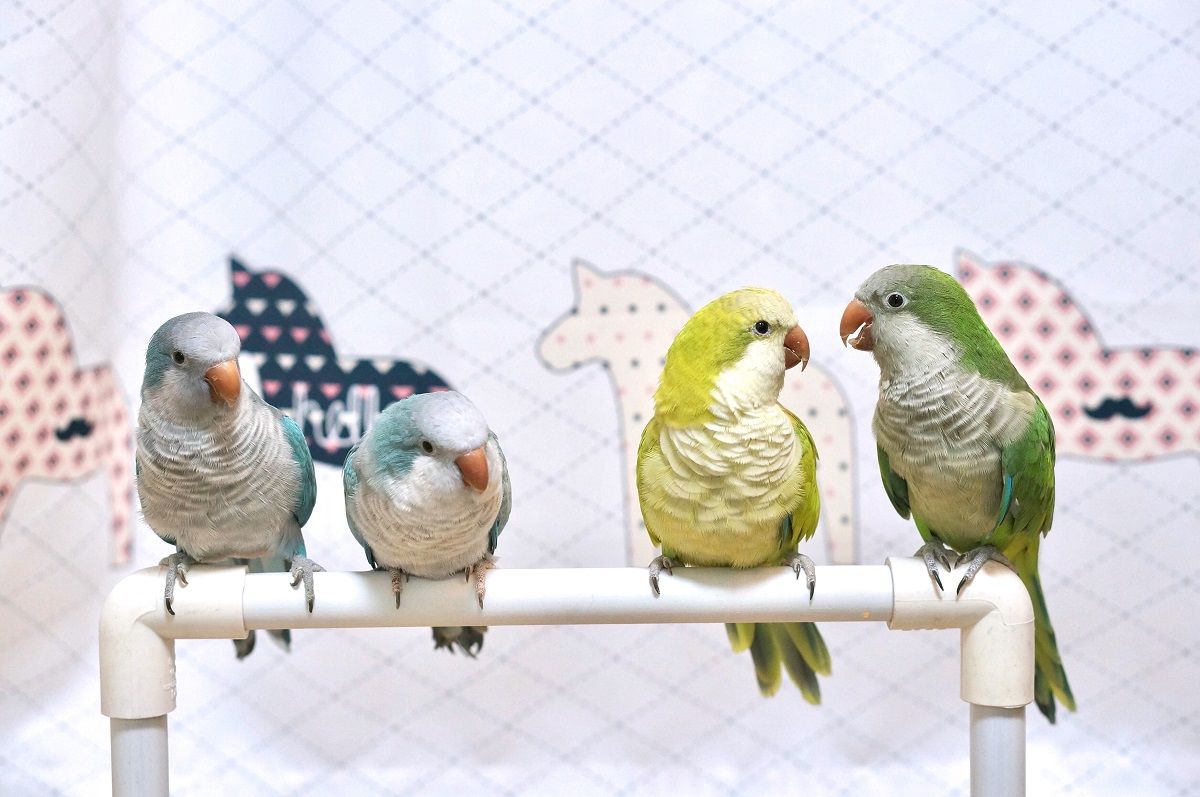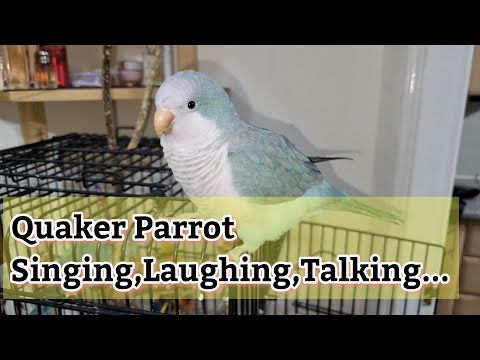Thinking about getting a parrot and considering Myiopsitta monachus, better known as the quaker parrot or monk parakeet? Nice choice! Although they’re not for everyone, these cheerful South American parrots can make great pets for the right owner.
Below, you’ll find everything you need to know about your new feathered friend, including where quakers are from, what they eat, and how to care for them.
| Name(s) (common, scientific) | Quaker parrot, monk parakeet, Myiopsitta monachus |
| Natural habitat | Argentina and surrounding countries |
| Adult size | Up to 13″ long and 140 grams |
| Lifespan | Up to 30 years |
| Noise level | Low to moderate |
Quaker parrot appearance
The quaker parrot is a small parrot species weighing up to 140 grams. It’s easy to recognize, with wild birds sporting a mossy green back, grey front, blue flight feathers, long tails, and a distinctive skin-colored beak.
Selective breeding has produced a variety of differently colored quaker parrots. You can now find them not just in green, but also blue, yellow, grey, white, and more.
Did you know? Although female quaker parrots are slightly smaller than males, the difference is almost impossible to tell visually. You’re better off DNA testing your bird if you want to be sure.

Quaker parrot range & natural habitat
Quaker parrots are naturally found in South America. Specifically, they inhabit a small part of southern Brazil, eastern Bolivia, most of Paraguay and Argentina, and all of Uruguay.
This is a lowland species that prefers regions up to 3,300ft in elevation. Here, it can be found in wooded to sparsely wooded areas, like (palm) forest, savannah, and urban parks.
Conservation status
The IUCN Red List considers Myiopsitta monachus to be a species of Least Concern. It notes that it’s locally common, and it may actually be benefiting from the destruction of its natural habitat.
Notably, Eucalyptus forests are being planted for paper pulp production, which provides these parrots with more spots to nest. On top of that, the expansion of agriculture means more crops (particularly maize) for them to eat.
Unfortunately, the same can’t be said for the only other species in the genus Myiopsitta, the very similar M. luchsi. It’s considered Near Threatened.
Invasive species
Like various other parrot species, such as the Indian ringneck, quakers have huge invasive potential. Self-sustaining populations exist in many different countries, including the US.
I live in Spain myself and see quakers all the time in larger cities like Valencia and Madrid! They like to hang out with the pigeons and forage for edible bits on the ground.
Although spotting feral parrots is kind of cool, these invasive birds unfortunately wreak havoc on local ecosystems. You can read more about the dangers and the resulting ban on quaker parrots in some areas in: Why are quaker parrots illegal?
Did you know? Parrots have the potential to live for many years, and this species is no exception. You can read more in the guide to quaker parrot lifespan.

Quaker parrot diet
Wild diet
Wild quaker parrots eat a varied diet. They’re mostly herbivores, preferring foods like seeds, wild fruits, and cactus stems. However, they won’t say no to bugs and grubs either if they happen to come across them.
Because quakers have such a taste for seeds, they’re considered farm pests in their natural range. Flocks will visit agricultural fields to gorge on corn and grain.
Captive diet
One of the most important things you can do to ensure your pet quaker parrot lives a long and happy life is to feed it a healthy and varied diet. Skip the classic seed mix—veterinarians nowadays agree that feeding a seed-heavy diet can lead to malnutrition.
A healthy quaker parrot diet should start with a high-quality formulated pellet food. Although these pellets look a little boring, they contain all the essential nutrients your bird requires.
Then, you can spruce things up by feeding a variety of the following:
- Lots of fresh vegetables
- Some fresh fruits
- Occasional high-quality seed mix
- Sprouted grains
- Boiled unsalted pasta or rice
- Grasses and bird-safe garden weeds
- Some egg or the occasional cricket/mealworm
Make sure the bird also has access to a mineral block and, of course, multiple sources of fresh water.
Remember, a healthy diet is crucial to a healthy, long-lived quaker. If you’re thinking of adding one parrot to your family, I highly recommend checking out the full guide to parrot diet to learn more about the what & why.

Quaker parrot housing
Although quakers are by no means the largest parrots out there, they still need plenty of space to move around and stretch their wings comfortably. A 30″ wide cage should be considered the minimum.
If you’re not planning on letting your bird roam free for at least a few hours a day, you’ll have to invest in a full-sized aviary. Remember that cage length is more important than height, as parrots really only tend to use the top half of their cage.
Your quaker’s cage should contain a variety of natural wood perches, especially near the top. It should also have a variety of toys, plus clean food and water bowls.
Nest building
If you leave elongated small items like sticks, glasses, pens, and the like around the cage, your quaker’s nest-building instinct may be triggered. It will choose a spot and start meticulously stacking everything it can find.
Some parrot owners try to prevent this because nesting can make your bird hormonal and cranky, but it’s difficult to get them to stop doing it. Plus, it’s just so cool to see these little feathered engineers doing their thing!

Quaker parrot enrichment
As you may be aware, parrots are time-consuming pets. This is because they’re highly intelligent and bore easily. They will become stressed, loud, or even aggressive without plenty of enrichment, and need nearly constant attention.
To prevent boredom, provide your quaker parrot with toys, climbing opportunities, foraging boxes, and anything else you can think of to keep it entertained in its cage. Do make sure all toys are parrot-safe; replace them when they become too damaged.
Another important part of enrichment is spending time with your parrot. A quaker kept solo, without a mate, will quickly become very lonely and stressed if it can’t play or even just hang out with you for most of the day.
Lastly, unless you keep your bird(s) in an aviary, you’ll have to provide time out of the cage on a daily basis. Lack of exercise can cause obesity in parrots just like an improper diet can! You can set up a parrot play gym on top of the cage for a nice birdie hang-out spot.
Keep in mind that any room your quaker parrot has access to should be “bird-proofed“. A whirling ceiling fan or hot cup of coffee may mean nothing to us, but can severely harm a parrot.
Did you know? What do you do when your quaker parrot is bleeding? Do you have the tools to remove a wood splinter from its foot? Do you have the number for an avian vet on hand? Make sure you know what to do in emergency situations.
Quaker parrot temperament
All parrots have big personalities, but quakers in particular are known for their confidence, boisterousness, playfulness, and overall zest for life. A well-socialized quaker parrot is clownish and a joy to have around, but will also be highly chaotic.
These birds are very social and if they’re used to humans, they’ll really savor your attention. Some can be pretty cuddly! However, they can also become attached to a single person, potentially causing aggression towards the rest of the family.
It’s also important to keep in mind that quakers take their cages very seriously. They can become highly territorial about what they consider their space, potentially making things like changing their water or food difficult.
Did you know? The quaker parrot’s common name has nothing to do with religion. It’s more literal! Younger birds especially will beg for food by flapping their wings and “quaking”.
Quaker parrot sounds
Although they’re not the loudest among parrots, quaker parrots are definitely not silent. I’d rank them as low-medium in terms of noise, but their flock calls are still quite grating.
Aside from screams and squawks, a quaker parrot will produce a steady stream of whistles and chirps. You may even hear yours practicing human language and imitating common household sounds!
You should always make sure you can handle a parrot’s noise level before you add one to your family. Listen on xeno-canto or see if you can visit a friend or breeder who has a quaker parrot before you buy one yourself.
Did you know? A happy and comfortable quaker parrot can produce a “purring” sound. Like many other parrots, they may also grind their beaks when they’re content.
Can quaker parrots talk?
In my post on the best talking parrots, I rank quakers among the good talkers (though remember that this means imitation—they don’t really know what they’re saying). Their voices are very squeaky, but they tend to be quite motivated to learn and can acquire impressive vocabularies.
If you’d like to teach your quaker some words, phrases, or tunes, repetition is key. You can read more in the full post on quaker parrot talking to find out how to train yours.
If you have any more questions about quaker parrots, or if you’d like to share your own experiences with these cheerful but invasive green birds, don’t hesitate to leave a comment below!
Sources & further reading

